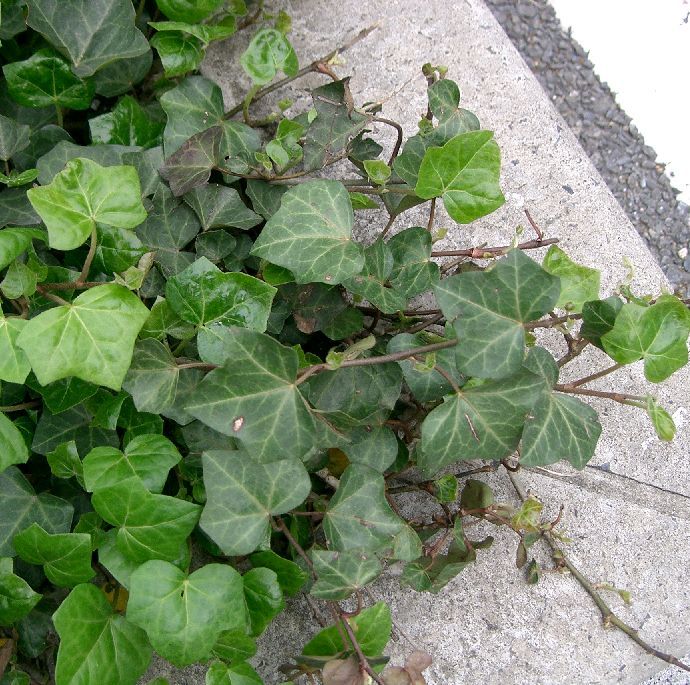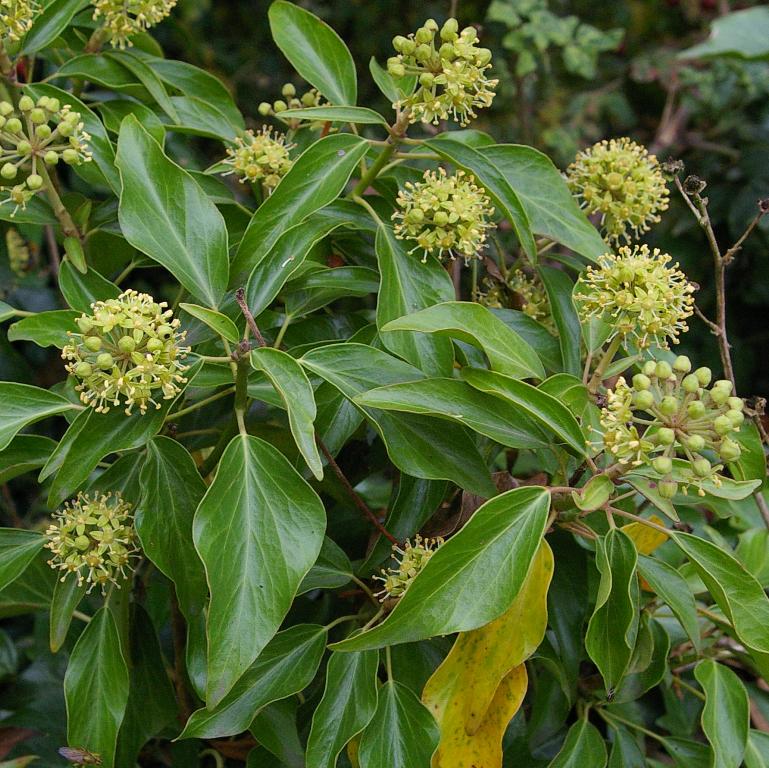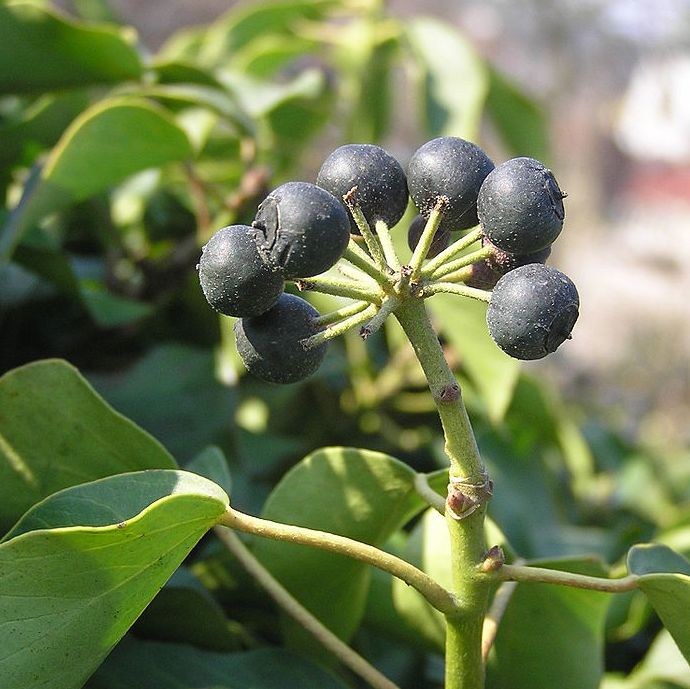The ivy on our wall has been looking fabulous again last year and providing the bees and wasps, as well as the odd butterfly some late nectar.
Then afterwards the black berries lasted until late spring as a nutritious food for our resident birds, mainly wood pigeons and blackbirds seem to enjoy them!
At present; May 2021, it is a nesting site for a couple of hedge sparrows (or dunnocks) and blackbirds.
So you could say that it is a heaven for our wildlife!

Many gardeners despise it though but it has many good uses for us too as you can find out on the following page.
Contents:
General Description
Two types of leaves
Environmental and Wildlife Uses
Toxicity and ethnomedical uses
Medicinal uses
Ornamental Use
Other Use
General Description
Hedera is the generic term for ivy and we got several species growing in the B.I. which are all garden escapes. Only H. helix is the native or Common Ivy.
It is a species of flowering plant in the family Araliaceae, which is family number 143 in Stace. The specific epithet helix derives from Ancient Greek meaning “twist, turn’.
As a Christmas decoration, Ivy has not retained its place with Holly and Mistletoe, but it was credited with the same kind of magical powers. It seems mournful and crepuscular belonging to ruins yet having the power to bury the masonry in its dark habit. It is thus a Gothic plant and not one to be seen on classical stone or modern brickwork. Ivy was a plant sacred to Osiris for the Ancient Egyptians and for Dionysus in spite of the belief that its addition to wine lessened the likelihood of getting drunk.
People love or hate to have it in their gardens, but ivy is a versatile plant which can reach to 30 m high on suitable surfaces such as walls and into trees.
It climbs by means of aerial rootlets which cling strongly to the substrate. The ability to climb on surfaces varies with the variety and other factors: Hedera helix prefers non-reflective, darker and rough surfaces with near-neutral pH. The plant generally thrives in a wide range of soil pH with 6.5 being ideal, prefers moist, shady locations and avoids exposure to direct sunlight, the latter promoting drying out in winter.


Two types of leaves
The leaves are alternate and they are of two types, with palmately five-lobed juvenile leaves on creeping and climbing stems, and unlobed, cordate adult leaves on fertile flowering stems exposed to good light, usually high in the crowns of trees or the top of walls in urban areas.
If there is nowhere to climb for the ivy it can also form a suitable groundcover surviving in deep shade where no other plant can! The juvenile state as well as ornamental varieties can be used as a trailing plant or grown into a frame to form topiary. The adult state which can occasionally be found in nurseries or garden cetres makes an attractive late flowering roundish shrub.
The flowers are produced from late summer until late autumn, individually small, in 3-to-5 cm-diameter (1 to 2’) umbels, greenish-yellow, and very rich in nectar, an important late autumn food source for bees and other insects.

The fruit are purple-black, ripening in late winter, and are an important food for many birds. Although they are almost certainly not edible, there is a report that the seeds contain 16.2% protein and 35.1% fat so brilliant food for birds during the winter months!
One to five seeds are in each berry, which are dispersed after being eaten by birds.
Environmental and Wildlife Uses:
Within its native range, the species is greatly valued for attracting wildlife. The flowers are visited by over 70 species of nectar-feeding insects, and the berries eaten by at least 16 species of birds. The foliage provides dense evergreen shelter, and is also browsed by deer.
In Europe, it is frequently planted to cover walls and is recommended to grow on buildings for its ability to cool the interior in summer, while providing insulation in winter, as well as protecting the covered building from soil moisture, temperature fluctuations and direct exposure to heavy weather.
Further uses include weed suppression in plantings, beautifying unsightly facades and providing additional green by growing on tree trunks.
However, on a negative note, ivy can be problematic! Its virtues can also be seen as a disadvantage. It is a fast-growing, self-clinging climber that is capable of causing damage to brickwork, guttering, etc., and hiding potentially serious structural faults, as well as harbouring unwelcome pests. Careful planning and placement are essential.
My own experience is that pruning or removing of ivy from walls can be awkward for the eyes and throat. Use a face mask or do it on a wet/rainy day!
A friend of mine recently had a very unpleasant enconter with ivy unfortunately! He developed a very painful rash all over his arms, and could not sleep for days! It only got better after taking steroids. See below information on Toxicity. I had to remove the culprit, which was a beautiful garden variety called Hedera colchica ‘Dentata Variegata’ a form of Persian Ivy and will also have to remove the plain, native one soon in their garden!
Here is the following information from Wikipedia:
Toxicity and ethnomedical uses
- Ivy berries are somewhat poisonous to humans, but ivy extracts are part of current cough medicines.
In the past, the leaves and berries were taken orally as an expectorant to treat cough and bronchitis. In 1597, the British herbalist John Gerard recommended water infused with ivy leaves as a wash for sore or watering eyes.
- The leaves can cause severe contact dermatitis in some people. People who have this allergy (strictly a type IV hypersensitivity) are also likely to react to carrots and other members of the Apiaceae as they contain the same allergen, falcarinol.
- Owing to the large number of saponins in the leaves and fruits of H. helix, it is mildly poisonous to animals like rabbits and can lead to anemia.
Medicinal uses:
Some additional notes and uses found on the PFAF website. This plant should only be used under the supervision of a qualified practitioner!
- a folk remedy in the treatment of rheumatism and as an external application to skin eruptions, swollen tissue, painful joints, burns and suppurating cuts.
- effective against liver flukes, molluscs, internal parasites and fungal infections
- The plant is used internally in the treatment of gout, rheumatic pain, whooping cough, bronchitis and as a parasiticide.
- An infusion of the twigs in oil is recommended for the treatment of sunburn.
Ornamental Use:
The common ivy is widely cultivated as an ornamental plant in gardens or in pots.
Over 30 cultivars have been selected for such traits as yellow, white, variegated (e.g., ‘Glacier’), and/or deeply lobed leaves (e.g. ‘Sagittifolia’), purple stems, and slow, dwarfed growth.
The following cultivars have gained the Royal Horticultural Society‘s Award of Garden Merit
- ‘Angularis Aurea’
- ’Buttercup’
- ‘Caecilia’
- ’Ceridwen’
- ‘Congesta’
- ‘Duckfoot’
- ‘Glacier’
- ‘Goldchild’
- ’Golden Ingot’
- ‘Manda’s Crested’
- ‘Midas Touch’
- ‘Parsley Crested’
- ’Shamrock’
- ‘Spetchley’
Other Use:
How To Make English Ivy Laundry Soap – DIY Natural Washing Detergent; see in this YouTube video: https://www.youtube.com/watch?v=MyPgStaMDV8
